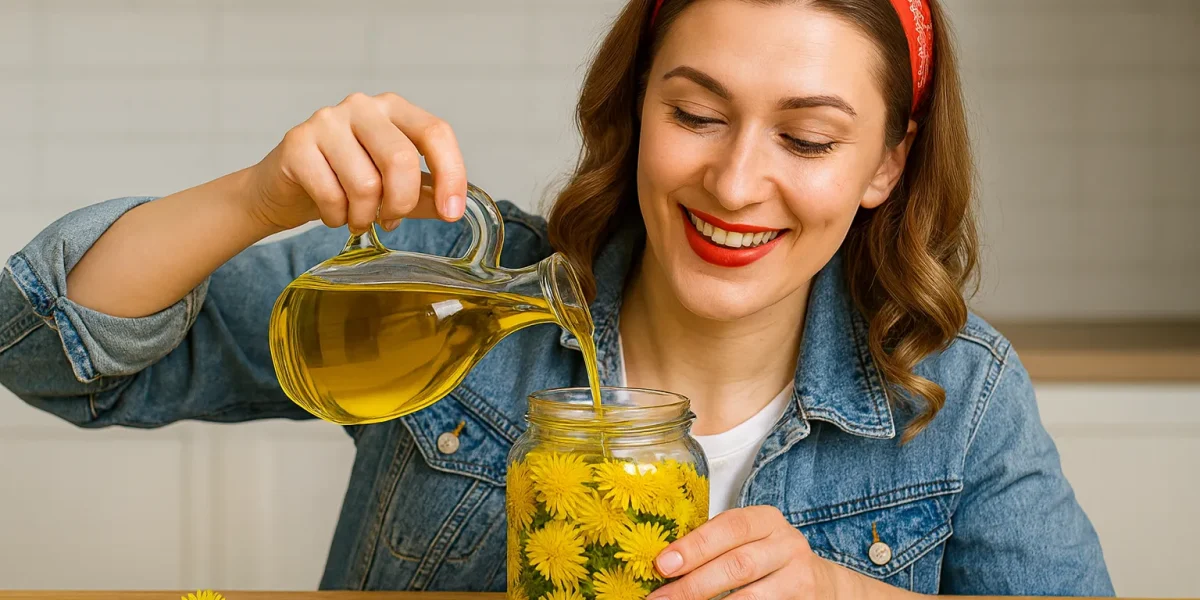Every spring, the yard fills with bright yellow blooms that most people rush to mow down. But before you grab the lawn tools, take a closer look—those dandelions are more than “weeds.” They’re edible, medicinal, and incredibly versatile. My personal favorite way to enjoy them is by making dandelion infused oil, a simple DIY that turns those humble flowers into a soothing, golden treasure for your skin and body.
In this guide, I’ll share everything I’ve learned about dandelions: how to make oil, sip tea, toss a fresh salad, and even craft a healing salve. Along the way, we’ll explore the many uses for dandelion, the surprising dandelion health benefits, and a few things you need to know about dandelion allergies.
Dandelion Tea: A Comforting Everyday Brew
There’s something calming about wrapping your hands around a warm mug of dandelion tea. Made from the plant’s leaves, flowers, or roasted roots, it’s earthy and smooth—perfect for winding down or giving your digestion a gentle push.
The roasted root version is often called “dandelion coffee” because of its rich, nutty flavor. It’s caffeine-free, yet many people swear it provides the same grounding feeling without the jitters. Beyond the taste, it supports hydration, helps with bloating, and has a mild detoxifying effect.
Dandelion Salad: Fresh, Bold, and Full of Flavor
I’ll never forget the first time I tried dandelion salad—it was simple recipe, just tender spring leaves tossed with olive oil, lemon juice, and garlic. The flavor was slightly bitter, but in the best way possible, waking up the palate like arugula does.
Dandelion greens are rich in vitamins A and K, and they’re one of the first wild foods to appear each year, making them perfect for foraging enthusiasts. You can add them to mixed greens, blend them into pesto, or sauté them lightly with olive oil and salt. When harvested young, the leaves are milder and perfect for everyday meals.
Dandelion Health Benefits: Why This “Weed” Is a Superfood
Dandelions have been used for centuries in folk medicine, and science is catching up to explain why. Here are some of the top dandelion health benefits:
- Digestive support: Dandelion leaves act as a natural diuretic, helping reduce bloating and supporting digestion.
- Liver health: Dandelion root is often used to support liver detoxification and function.
- Anti-inflammatory effects: The flowers contain antioxidants that may soothe inflammation in the body.
- Skin health: When applied topically, dandelion infused oil nourishes dry, irritated skin.
- Nutrient density: Dandelion greens are packed with vitamins A, C, and K, plus minerals like calcium, potassium, and magnesium.
This little plant truly punches above its weight in nutrition and wellness.
Uses for Dandelion: Beyond the Lawn
When you think about the uses for dandelion, it’s clear this plant is the definition of versatility. People all over the world use dandelions in food, drinks, herbal remedies, and even homemade beauty products. Here are some of the most common ways to enjoy them:
- Fresh greens for salads, stir-fries, and smoothies
- Roasted roots for coffee substitutes
- Bright yellow petals for syrups, jellies, and wine
- Infused oils for skincare and massage
- Balms and salves for dry skin or sore muscles
The more you experiment with dandelions, the more you’ll realize just how abundant and useful they are.
Dandelion Salve Recipe: Nature’s Balm in a Tin
Once you’ve made a batch of dandelion infused oil, the next step is often creating a salve. This balm is perfect for tired hands, cracked heels, or sore joints, and it’s incredibly easy to make.
Simple Dandelion Salve Recipe
Ingredients:
- 1 cup dandelion infused oil
- ¼ cup beeswax pellets
- Optional: a few drops of lavender or chamomile essential oil
Directions:
- Melt the beeswax and dandelion oil together using a double boiler.
- Stir in the essential oil, if desired.
- Pour the mixture into small tins or jars.
- Let it cool completely before using.
The result is a creamy, golden balm that’s deeply soothing and 100% natural.
How to Make Dandelion Oil: A Step-by-Step Guide
Making dandelion infused oil at home is one of the simplest, most rewarding DIYs I’ve ever tried. Here’s how you can do it too:
- Harvest flowers – Pick fresh dandelion blooms from an area free of pesticides or pet traffic.
- Dry them out – Lay the flowers on a towel for 24–48 hours to reduce moisture and prevent mold.
- Fill a jar – Place the dried flowers in a clean glass jar, filling it about halfway.
- Add oil – Pour a carrier oil (like olive, sweet almond, or jojoba) over the flowers until fully covered.
- Infuse – Seal the jar and leave it in a sunny spot for 2–3 weeks, gently shaking daily.
- Strain – Once infused, strain the oil through cheesecloth to remove the plant matter.
- Store – Keep the oil in a dark glass bottle in a cool place for up to six months.
That’s it—you’ve just bottled up nature’s golden goodness.
Dandelion Allergies: A Word of Caution
While dandelions are safe for most people, a small percentage may experience dandelion allergies. The most common reactions include:
- Skin irritation after direct contact
- Sneezing, watery eyes, or congestion from pollen
- Upset stomach if consumed in large amounts
If you’re allergic to ragweed, daisies, or marigolds, you may also be sensitive to dandelions. Always do a patch test before applying dandelion infused oil to your skin, and check with your doctor if you’re unsure.
Why Dandelions Deserve a Place in Your Life
From tea and salads to infused oils and homemade salves, dandelions have proven themselves as more than just weeds. They’re nourishing, healing, and accessible to almost anyone willing to look at their yard differently.
Learning how to make dandelion oil was a game-changer for me. Not only did I discover a natural remedy for sore muscles and dry skin, but I also found a way to appreciate the wild abundance growing right outside my door.
So the next time you see a sea of yellow blooms, pause before you pull them out. Maybe gather a handful instead, and let dandelions remind you of the beauty in the ordinary.
FAQs
Dandelion infused oil is often applied to soothe sore muscles, moisturize dry skin, and ease minor aches. It’s also a base for natural salves and balms.
Harvest pesticide-free flowers, dry them for 24–48 hours, then cover them with a carrier oil in a jar. Let it sit for 2–3 weeks before straining.
Yes, dandelion tea is safe for most people when consumed in moderation. It’s caffeine-free and supports digestion and hydration.
Dandelions are rich in vitamins A, C, and K, and support liver health, digestion, and skin repair. They also contain antioxidants that reduce inflammation.
Young dandelion greens can be tossed with olive oil, lemon juice, garlic, and salt. The flavor is fresh, slightly bitter, and packed with nutrients.
Dandelion salve is made from infused oil, beeswax, and optional essential oils. It’s great for chapped skin, sore joints, and everyday skincare.
Yes, some people may react with skin irritation, digestive upset, or pollen sensitivity. If allergic to ragweed or daisies, proceed with caution.













